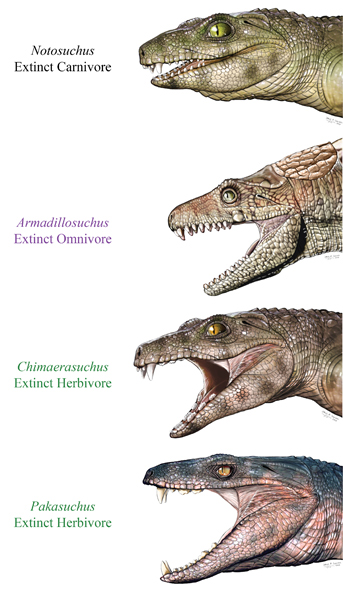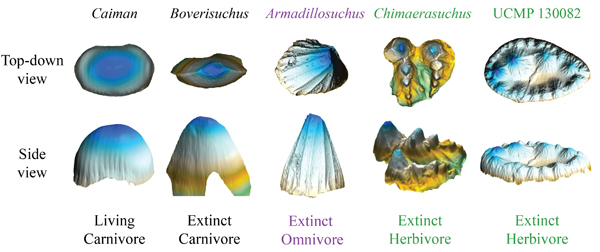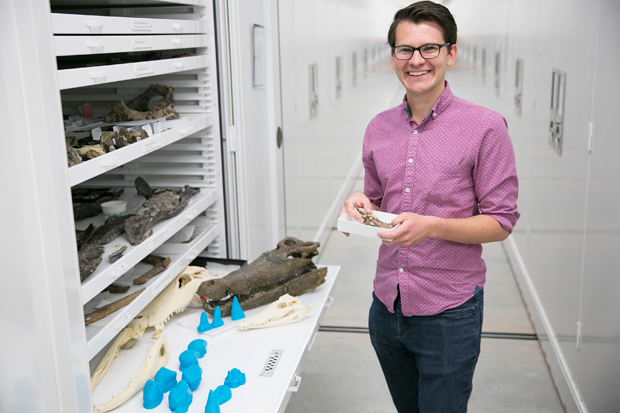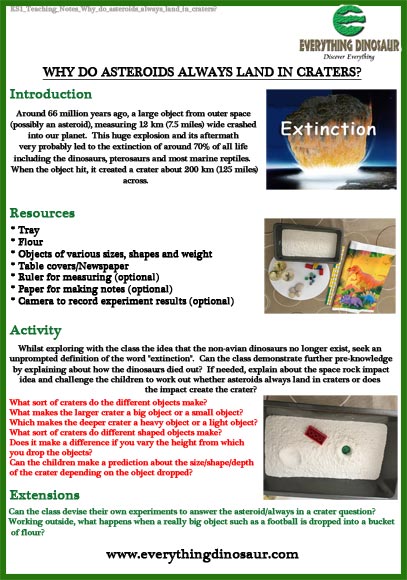Repeated Evolution of Herbivorous Crocodyliforms
Fossil Teeth Suggests Lots of Different Types of Mesozoic Crocodiles
Researchers from the University of Utah have studied the teeth of extinct crocodyliforms and concluded that crocodiles occupied a large range of different ecological niches during the Age of Dinosaurs. Furthermore, these geographically widespread and speciose reptiles adapted to a variety of diets and that herbivorous crocodyliforms evolved at least three times independently. This suggests that plant-eating was a beneficial dietary strategy and not a unique occurrence. Many of these crocodyliforms lived alongside omnivorous or herbivorous synapsids, illustrating an ecological partition that is not found today.
The Diets of Extinct Crocodyliforms were Diverse with Many Examples of Herbivory Identified

Picture credit: Jorge Gonzalez
Mesozoic Crocodiles
Writing in the academic paper “Current Biology”, the researchers Keegan Melstrom and Randall Irmis at the Natural History Museum of Utah at the University of Utah, discovered that multiple ancient groups of crocodyliforms (the group including living and extinct relatives of crocodiles and alligators), were not all carnivorous. Research has been conducted before on the various potential dietary niches of ancient crocodiles, but this new study proposes that vegetarianism arose at least three times within this group.
Commenting on the significance of this new study, doctoral student Keegan Melstrom stated:
“The most interesting thing we discovered was how frequently it seems extinct crocodyliforms ate plants. Our study indicates that complexly shaped teeth, which we infer to indicate herbivory, appear in the extinct relatives of crocodiles at least three times and maybe as many as six.”
Teeth Variation within Crocodyliforms (Extinct and Extant)

Picture credit: Keegan Melstrom (The Natural History Museum of Utah)
The Tip of the Crocodyliform Iceberg
The twenty plus species of crocodylians alive today possess a similar general body shape and ecology. They are mainly generalist hypercarnivores and semi-aquatic, confined to lower latitudes. Although, consuming fruit and vegetable matter has been observed in several extant species. In 2013, Everything Dinosaur wrote an article about fruit consumption (frugivory), in crocodiles.
To read the article: New Study Suggests a Number of Different Types of Crocodylian Consume Fruit.
The crocodiles alive today, all have similar, simple conical teeth but the fossil record shows that extinct crocodyliforms were much more diverse. Today’s crocodiles are just the remnants from a once much richer and more specious group of reptiles, consider the living crocodylians as the “tip of the crocodyliform iceberg”.
Living Crocodiles are Generalist Ambush Predators (Hypercarnivores)

Picture credit: Everything Dinosaur
The researchers identified different teeth morphologies (heterodonty) and this suggests that in the past crocodile-like creatures had a variety of diets.
Melstrom added:
“Carnivores possess simple teeth whereas herbivores have much more complex teeth. Omnivores, organisms that eat both plant and animal material, fall somewhere in between. Part of my earlier research showed that this pattern holds in living reptiles that have teeth, such as crocodylians and lizards. So, these results told us that the basic pattern between diet and teeth is found in both mammals and reptiles, despite very different tooth shapes, and is applicable to extinct reptiles.”
Keegan Melstrom (The Natural History Museum of Utah) with Some of the Casts Used in the Study

Picture credit: The Natural History Museum of Utah
Comparing Tooth Complexity – Extinct versus Extant
To deduce what long dead crocodyliforms most likely consumed, Melstrom with the assistance of his graduate advisor ( Randall B. Irmis), compared the tooth complexity of extinct crocodyliforms to those of living animals using a research methodology originally designed to study mammalian heterodonty. In total, 146 teeth from 16 different species of extinct crocodyliforms were incorporated into the study.
Using a combination of quantitative dental measurements and an assessment morphological features, the scientists reconstructed the diets of those extinct animals. The results indicate that these animals had a wider range of dental complexities and presumed dietary ecologies than had been appreciated previously. Quantitative analyses also revealed that some species with complex dentition were likely to be herbivorous.
The researchers conclude that plant-eating crocodyliforms appeared early in the group, perhaps shortly after the end-Triassic mass extinction event and herbivory persisted until the end of the Age of Dinosaurs. The analysis suggests that herbivory arose independently a minimum of three times, and possibly six times, in Mesozoic crocodyliforms.
Melstrom stated:
“Our work demonstrates that extinct crocodyliforms had an incredibly varied diet. Some were similar to living crocodylians and were primarily carnivorous, others were omnivores and still others likely specialised in eating plants. The herbivores lived on different continents at different times, some alongside mammals and mammal relatives, and others did not. This suggests that herbivorous crocodyliforms were successful in a variety of environments!”
Herbivorous Crocodyliforms
As many of these herbivorous crocodyliforms co-existed with plant-eating synapsids including Mammaliaformes, some of which were the ancestors of today’s mammals, this was an ecological partition that is no longer found on our planet.
The scientific paper: “Repeated Evolution of Herbivorous Crocodyliforms during the Age of Dinosaurs” by Keegan M. Melstrom and Randall B. Irmis published in Current Biology.
Everything Dinosaur acknowledges the assistance of a press release from the University of Utah in the compilation of this article.
The Everything Dinosaur website: Everything Dinosaur.



